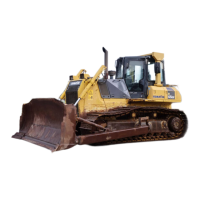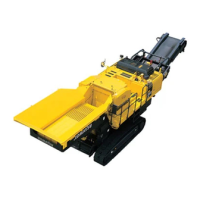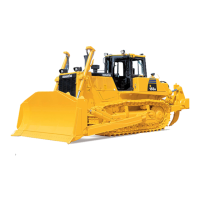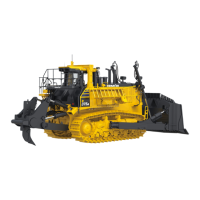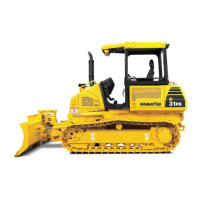.
OPERATION
TROUBLESHOOTING
TOWING THE MACHINE
WARNING
If any failure should occur in the brake system and the brakes will not work, then be extremely careful.
If the machine is towed in the wrong way, there is the danger of an accident that could cause death or injury.
Before releasing the brake, always put blocks under the wheels.
Only use wire rope that has enough strength for the weight that it is being towed.
Do not apply a load to the wire rope suddenly.
NOTICE
Towing is for moving the machine to a place where inspection and maintenance can be carried out, and not for moving it long
distances.
The machine must not be towed for long distances.
For details of the procedure for towing a machine when it has broken down, please contact your Komatsu distributor.
WHEN ENGINE CAN BE USED
Always keep the engine running when towing the machine, so that the steering and braking can be used.
WHEN ENGINE CANNOT BE USED
When towing a disabled machine the distance should be within 600 m (1968 ft) at a speed of 8 km/h (5.0 MPH)
or less.
If the distance is more than the above mentioned, or if more than 1 day has elapsed since the engine trouble, be
sure to use a trailer for transportation.
The parking brake is automatically applied. (A fixed time after the engine stops.)
It is necessary to release the parking brake, but the brake will then have no effect at all, so it is necessary to take
special measures to ensure safety when moving the machine. This is particularly important on slopes.
NOTICE
If the machine is towed without the engine running, no lubrication oil will be supplied to the transmission. The gears and bearings
are rotated, so this may cause them to be damaged.
Tow the machine properly according to the instructions given below.
The explanation given here is only to be used for a machine that has failed and is to be moved to a safe place for
repairs. It must be moved a maximum of 600 m (1968 ft) and at a maximum speed of 8 km/h (5.0 MPH). This
procedure is only for emergency purposes. If the machine must be moved a long distance, use a transporter.
To protect the operator if the towrope or bar should break, install a protector plate to the machine being towed.
If it is impossible to use the steering or brakes on the machine being towed, then do not have anyone sitting in
the operator's seat.
Before towing, check that the tow rope or bar are in good condition, and that they have ample strength for the
towing operation. If the machine being towed may get stuck in mud or may have to be towed uphill, the tow rope
or bar must be of a strength of at least 1.5 times greater than the weight of the machine being towed.
Keep the angle of the towing line to the minimum. Operate the machine so that the angle does not become greater
than 30 deg. from the straight line.
If the machine is moved suddenly, the towrope or bar will be subjected to an excessive load, and it may break.
Start the machine gradually and travel at a constant speed.
Normally, use a towing machine of about the same capacity as the machine being towed. The towing machine
must have ample brake capacity, weight, and rimpull. Check that both machines can be controlled on slopes and
on the tow road.
3 - 178
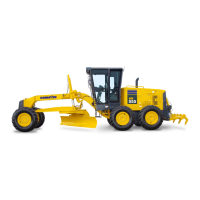
